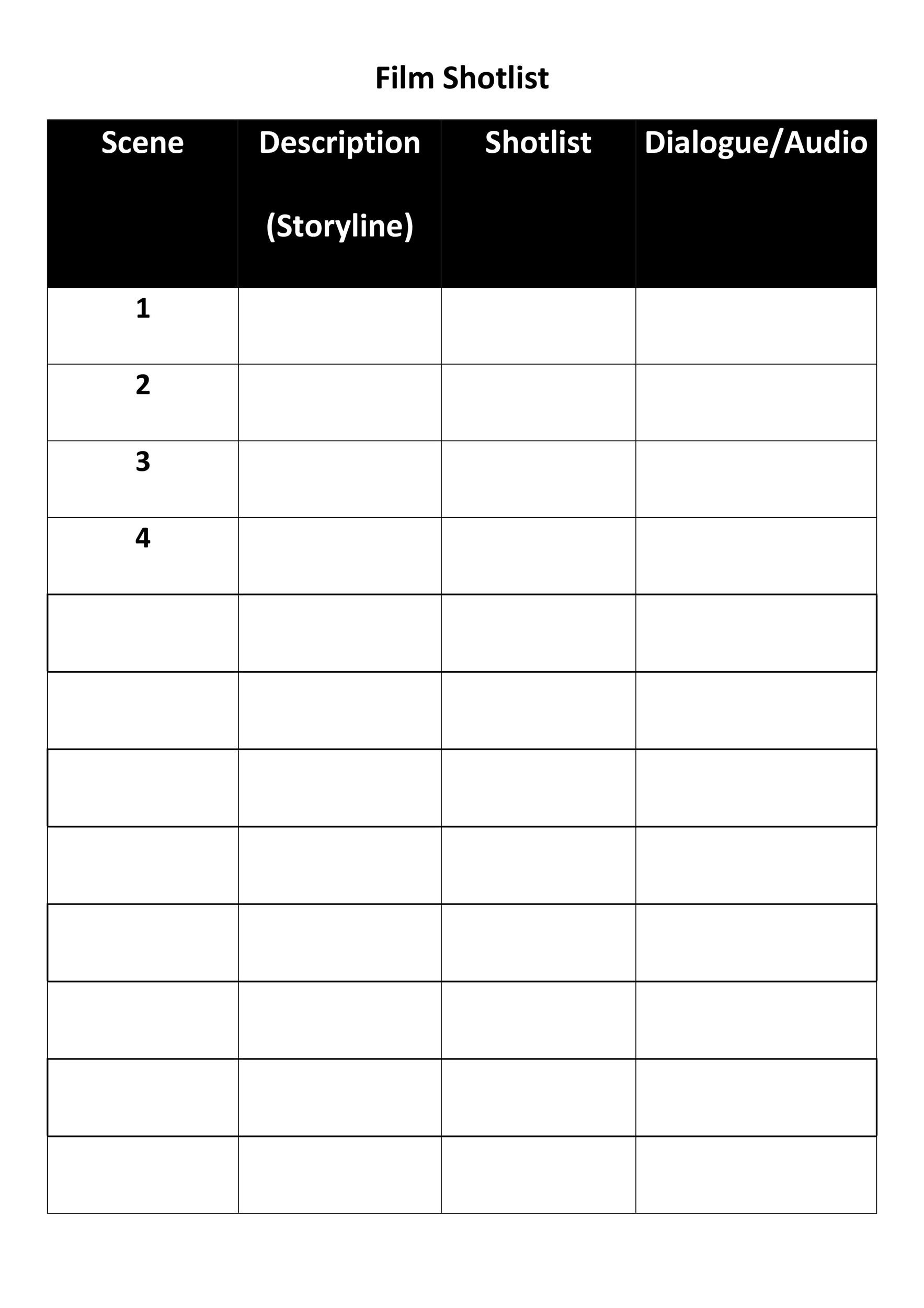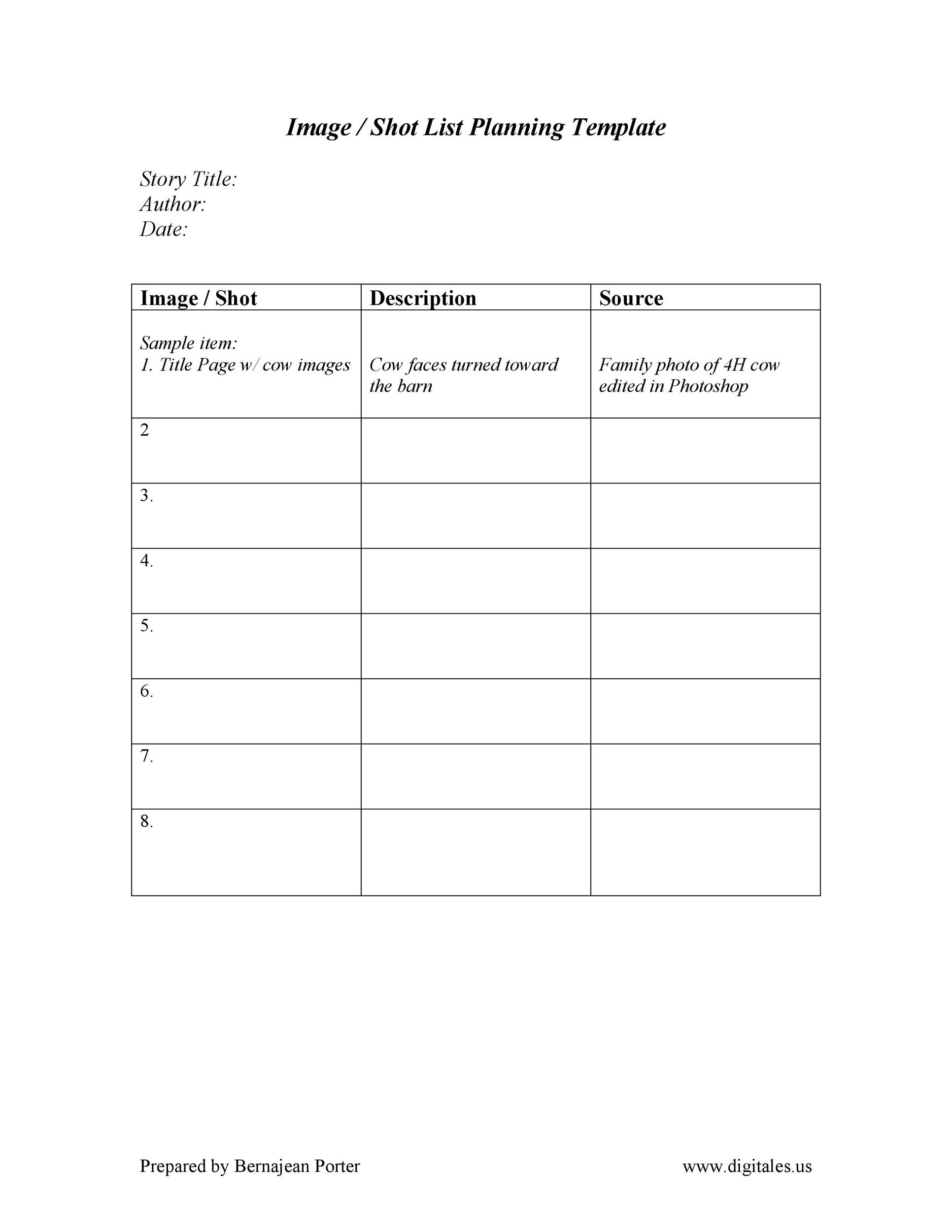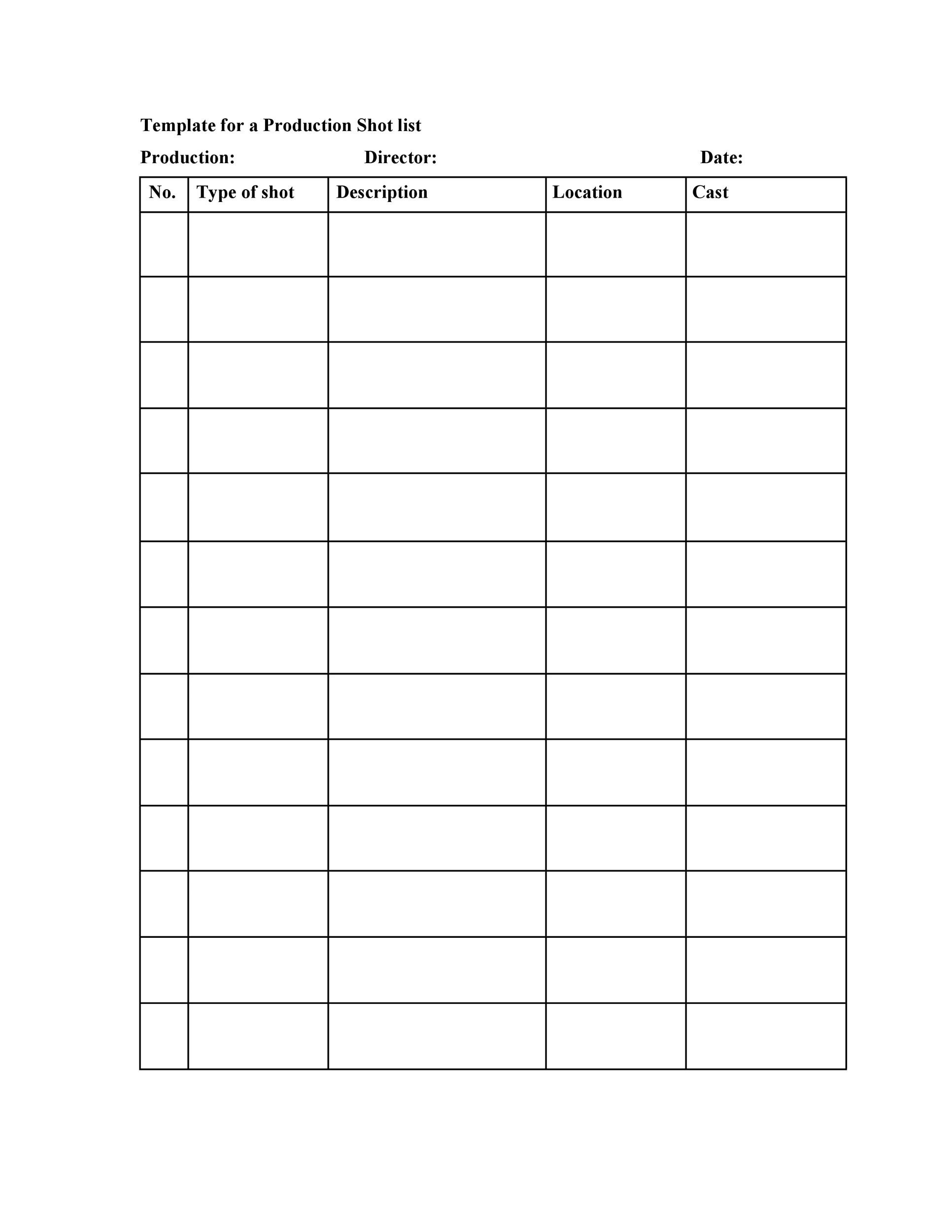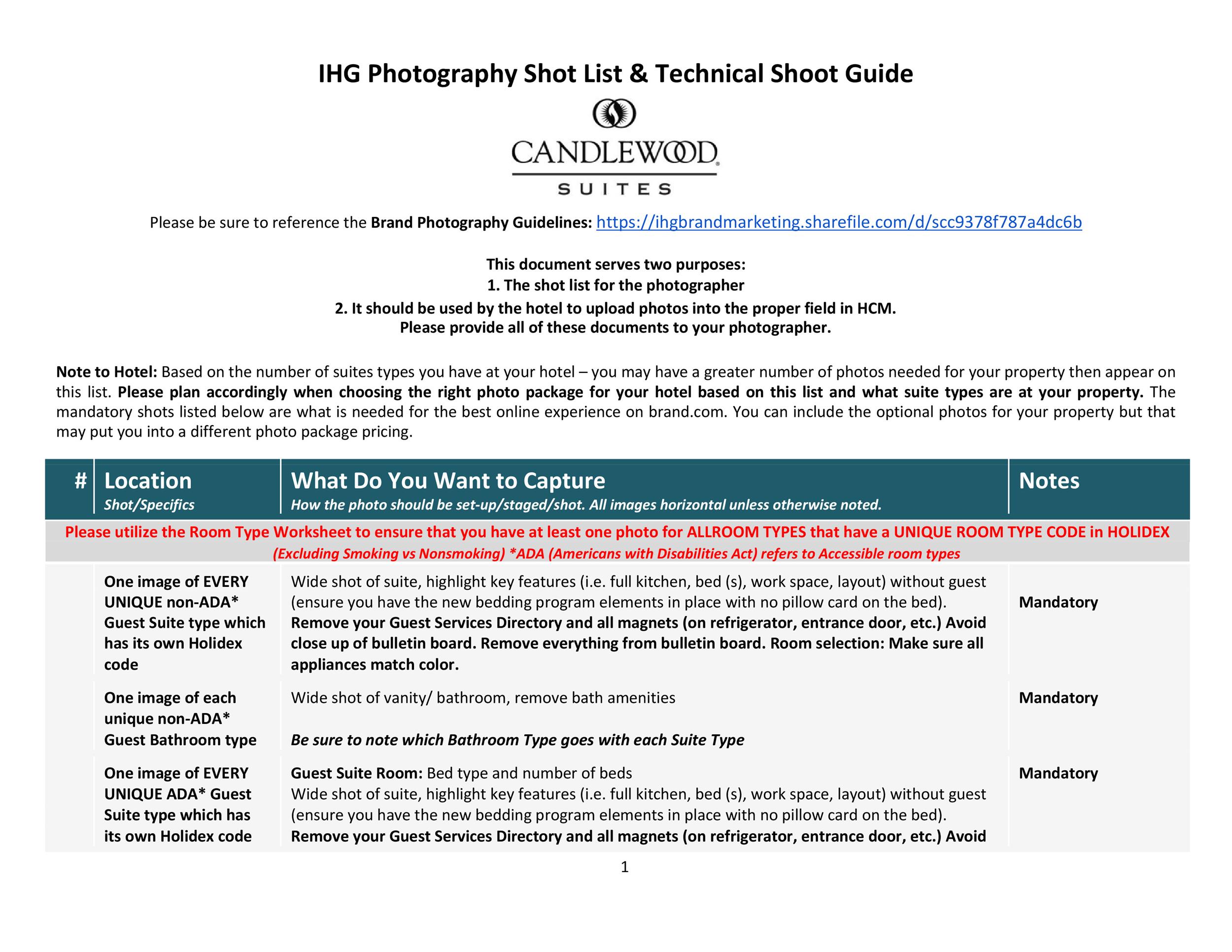A shot list template is an important document wherein you make a list of all the shots you want to get on a day of shooting. The document contains all of the important details for each of the shots. The film shot list template is also a strategic document you can use to communicate your vision clearly to your team.
Table of Contents
Shot List Templates
Elements of a shot list
Film students and budding directors can benefit a lot from using a shot list template. You can either download a film shot list template, a camera shot list template, a video shot list template or a photography shot list template and customize it according to your needs.
You also have the option to make your own template from scratch by using shot list examples as your reference. Either way, make sure to include these details:
- Scene Details
To make the document clearer and easier to use, break it up into scenes first. Then add the scene numbers, scene headings, and the pages above the list. - Setup Number
This refers to the unique preparation and placement of the lighting and the camera. Make sure to increase the setup number each time the equipment, camera position or camera angle changes. To make this part easier for the readers to understand, use color labels for the different setup numbers. - Shot Number
This refers to the reference number for a given row or shot. Start with number 1 on your list. For each new setup, reset the number back to 1. - Subject
This refers to the shot’s focus. For your subject, you can use a character, a group of characters, a prop, an establishing shot, and more. The subject helps you plan when the actors must report to the set or when you need to prepare a location or a prop. - Description
For this element, you must provide detailed descriptions for each of the shots. This can be a dialogue, actions or anything relevant to the shot. - Camera
You should also identify all of the individual cameras along with the specialty cameras, especially if you’re using a lot of them. - Shot Size
This refers to the size of your subject in the frame. - Shot Type or Camera Angles
This refers to the camera’s position in relation to your subject. If there is any change in the camera angle, create a new setup in the camera shot list. If the angle of the camera changes while you’re shooting, state this in your video shot list template as well. - Camera Movement
This refers to any movement of the camera while shooting. Since movements of complex cameras take a lot of time to set up, you may want to use these sparingly.
Shot List Examples
Different types of shots to include in your shot list template
One of the most important elements of your shot list template is the type of shot. Here are the different types of shots you can use in your shot list example:
- Close-up (CU)
- Extreme close-up (ECU)
- Medium close-up (MCU)
- Mid Shot (MS)
- Very wide shot (WVS)
- Wide shot (WS)
After identifying the types of shots in your film or photography shot list template, it’s time for you to identify your subject. As aforementioned, the subject can be one of the actors, a prop, a location, and more. Adding the description of each shot provides a clear guideline of what happens in every frame and how things move on to the next shot.
Film Shot List Templates
The description may include the actor who is part of the scene, what the actor will do, any props the actor will use, and what exactly will the camera focus on. After mapping out the direction of each shot, this makes it easier for you to start the process. Then once you’ve captured all of the shots, you can start bringing them together to build your video.
Camera Shot Lists
Tips for creating your shot list
An effective shot list template allows you to maximize the shooting time and limit your downtime across all of the departments. Now let’s take a look at the essentials of your show list example so that you can create the best photography or film shot list template possible:
- Make a breakdown of the script
If you want to organize all the details of the shot, you need to breakdown the script first. This proves useful to guide you later on. - Create a storyboard
This is an optional step but it’s very helpful. Layout the different types of shots to give you a better idea of what each shot would look like. If you plan to do this step, do it before you meet with the rest of the team. Come up with a storyboard along with annotations to match. This makes it easier for you to explain when you talk to the rest of your team.
Also, creating a storyboard proves helpful when you need to start creating the actual list. You can use it to take a look at all of the shots you’ve envisioned. The storyboard also influences the editing process to help you pare down your list. So, if you need a specific type of shot, you don’t have to capture it another way.
For this step, you can use a notebook or some blank sheets of paper. Separate the pages into boxes then label each of them with a number. Draw your vision of the first shot, then write the number 1 in the box. Then include any accompanying lines from the script to the illustration.
Keep doing this for each of the boxes working in chronological order based on the script. In some cases, shots may include several lines. To keep everything organized, add a note about the position or movement of the camera.
Since this is an optional step, you may choose not to create a storyboard. This is especially true if you have a simple shooting series or you feel confident about your knowledge of camera lingo. But if you want to keep everything organized so nothing gets forgotten, a storyboard will be a big help. - Make a draft of all the shots you want to include on your final list
Make a list of each of the unique shots from each of the unique scenes. After this, you can start organizing each of the scenes and include the storyboard numbers to them. That is if you created a storyboard. - Create a breakdown of the shooting day then re-organize your shot list template
One important part of the process is to breakdown the shooting days. Do this by complexity, availability of the actors, location, and other important factors. You must do this if you want to create a highly organized video shot list template.
In the beginning, you create a chronological list of all the shots based on the storyboard and the script. However, this isn’t too useful since shooting isn’t done chronologically. Instead, you must create a “shooting script” to make it easier for you to organize your shot list template. - Organize your camera shot list according to the order of filming
Now two sets are the same. Therefore, before you start shooting, you must speak to your team about the whole process. This is the final step for creating your shot list. Here are some pointers for you:
Begin with the most complicated shots. This way, the whole team is highly energized. Also, knowing that things get simpler as each shooting day progresses helps motivate you.
When shooting, try to cover as much as you can within one setup. This is why it’s important to come up with a script breakdown so you know exactly what you can shoot in each location.
When it comes to film inserts, you can set these up either at the end of the day or on the day itself. Inserts are the simplest kinds of shots because you don’t need sound for them and you only need a couple of seconds for each.
When filming inserts, schedule the shots on the day of your setup so you don’t have to add extra schedules for them. You can shoot these inserts at the end of the day while everything is still set up.
Always mind the schedules. Remember that shooting usually comes with a set timeframe. So, you must coordinate more than just your shot list. You must also check the schedules of your actors, the availability of the props and locations, and more.
If your actors aren’t available at the schedule you need to shoot, you must re-schedule as soon as possible. That way, you don’t have to waste a shooting day on inconsequential things. Also, you may save a lot of money if you organize everything more effectively.
The schedules of the actors also influence what’s known as “dirty shots” where you focus on one of the actors while other actors are still in view. Such shots require you to coordinate the schedules of different actors so they can all come on the same day.
























































